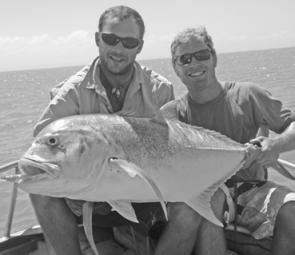Most of the fish in TNQ’s annual breeding, feeding and migratory patterns are geared around the wet season which can continue well into May/June. Now is the time to sit back and consider this crucial annual event.
In 2006, the rains began in early March and continued through April and into May. After looking at the last few years, it is clear that the wet is beginning later and is generally less significant than previous years’.
For most of the year, there are four keys to successful fishing: tide, temperature, time of day and transition of fish. However, the wet season reduces the importance of all but one of these factors. The transition of fish is crucial to the anglers’ success in March.
The fish will still get excited about any chance to eat a lure in March. However, they will be difficult to find as river levels rise and water clarity takes a plunge into shades of brown.
Pelagic species such as trevally, queenfish and mackerel will move offshore and be difficult to catch over the coming months. Tuna schools and sharks that can be found close inshore during winter will now be cooling their heals offshore, after following the huge schools of baitfish.
With northwesterly winds blowing onshore almost every afternoon, fishing around the river mouths, rocky headlands and beaches will probably be poor. If there has been any decent rain, most of Archer Bay will be turbid and not worth the effort.
March is when the recruitment process kicks into full swing. Fish with breeding cycles geared around the wet will begin to move up or down river systems depending on their individual persuasions.
Barramundi, which finished breeding in the months before Christmas, will be ready to travel in March. TNQ anglers can enjoy fantastic barra fishing around barrages and weirs or any natural barrier to the movement of fish upstream. Good places to fish are big drains and creek mouths where food is funnelled back into the main system.
Aurukun’s locals know March and April as the months when big barra actually push up and over the salt pans and into swampy country, following mullet schools through impossibly shallow water.
March is a good time to get out of town and visit places not affected by the threat of heat, rain, cyclones and flies. My travels over this year’s wet season took me to the east coast of the Cape on a brief fishing trip before heading south to the Gold and Sunshine coasts. On the first trip we managed to sneak out to the reef for a day’s trolling and scored a few nice Spanish mackerel and GTs. One GT set hearts racing as it inhaled the lure right on the transom and proceeded to rip 100m of drag in an instant!
Another memorable day was spent on Black Tie, a 40ft Blackwatch, out of Mooloolaba. We were switch-baiting blue marlin out around the Noosa canyons and skipper Dave Granville put me onto a 400lb+ monster. These blues can really go and the series of jumps performed around the boat was memorable stuff.
If you can’t get out of wherever it is the boss has you working, best grab a handful of shallow running barra lures and find a spot blocking the movement of fish upstream.
Reads: 883
I was fishing with Dave Granville on Black Tie when I hooked this 400lb+ monster.

On a recent trip to the Cape we managed to sneak out for a day’s fishing and land some nice GTs.




